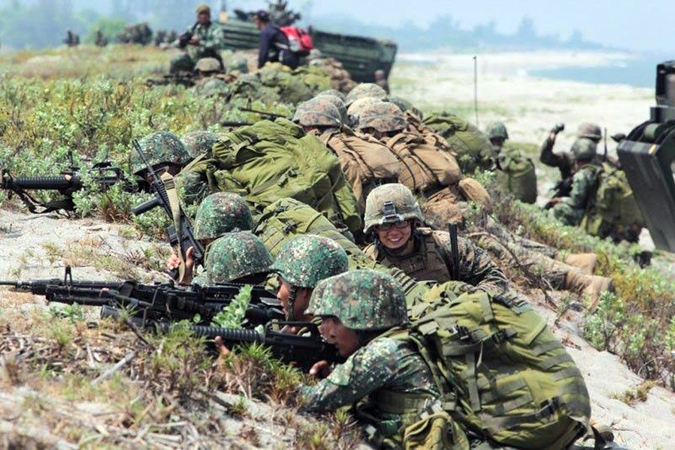
By Rasti Delizo
THE GEOGRAPHICAL LOCATION of the Philippines on the world map permanently defines its inimitable strategic position and geopolitical role in relation to America’s overall foreign policy framework and agenda. This principally means that the recent abrogation of the 1998 RP-US Visiting Forces Agreement (VFA) by the current Duterte Regime will inevitably give way to a potential VFA-2, or another similar bilateral defense arrangement, in the future. Such a scenario is a near certainty given two complementary conditions which continually press upon our country. One is internal, while the other remains external to the Philippines.
A major internal factor is that the 1951 RP-US Mutual Defense Treaty (MDT) still prevails after nearly 70 years. Fundamentally, the MDT persists as the principal bilateral instrument which continues to operationally bind Manila to Washington’s external policy thrusts aimed toward this area of the globe. In fact, even after the Philippine Senate voted to abrogate the much earlier 1947 RP-US Military Bases Agreement (MBA) in September 1991, US military forces were still able to conduct joint training exercises with the Armed Forces of the Philippines (AFP) on Philippine soil. Indeed, this happened even prior to the VFA getting signed into existence!
Undeniably, the MDT is the chief pact which opened the door for the VFA’s entry into our diplomatic terrain less than a decade after the US military bases were shut down in the early 1990s. Yet, it is also critically important to remember that even without the VFA, Malacañang still continues to retain other dangerous spawn of the MDT — the 2002 RP-US Mutual Logistics Support Agreement (MLSA) and the 2014 RP-US Enhanced Defense Cooperation Agreement (EDCA). Ominously, the latter allows for US military forces to assert relatively wide operational control over at least five Philippine military bases across the country today, and almost three decades after the MBA was terminated.
This perturbing arrangement is a part of both countries’ joint obligations to further deepen the scope of the MDT’s bilateral defense objectives which were set in motion since the last century’s Cold War phase. Indeed, the Philippine state’s tactical sacrifice of the VFA is merely a ploy to keep the MDT-MLSA-EDCA cornerstone in place to help secure America’s so-called “freedom of navigation operations” across the wider Asia-Pacific region. Thus, the Duterte Regime’s silence on the three war instruments truly exposes his real intention to protect his own political flanks from any American retaliation by ensuring such leverage with Washington through Manila’s retention of the age-old “Mother Defense Treaty” (MDT) itself.
On the other hand, the principal external pressure bearing upon the Philippines is the overall direction of American foreign policy as outlined by the 2017 US National Security Strategy paper. As the world’s leading superpower, America identifies both China and Russia as its foremost long-term challenger-competitors, together with Iran and North Korea. From this perspective, Washington believes that it must always be in a position to constantly assert its dominant hegemonic might to secure and advance its strategic interests worldwide by keeping a commanding edge over its main rivals for access and maneuver across the global commons.
And to maintain a strategic advantage over its core competitors, America’s central task must be to “retain overmatch… to ensure that American military superiority endures” throughout the world. Accordingly, Washington’s latest military strategy to retain its global overmatch is now defined as the Joint Concept for Access and Maneuver in the Global Commons (JAM-GC) — the highly evolved version of the Pentagon’s earlier Air-Sea Battle Concept — aimed at overcoming the anti-access/area-denial (A2/AD) countermeasures of China and Russia.
Therefore, the critical role played by America’s EDCA bases will crucially shape US imperialism’s future interventions in the Philippines under the JAM-GC’s doctrinal guidance to ensure America’s global overmatch against China. Within this setting, it is vital for the Philippines to be held as a critical security link to guarantee Washington’s forward force projection posture within and beyond Southeast Asia. Hence, we should once again expect the US to protect its foreign policy imperatives by pressuring Malacañang into accepting a post-VFA arrangement in the coming period. And such a scenario is geopolitically inevitable as the Philippines is forcibly sucked into the intensifying vortex of the “Neo-US-Sino Cold War” that is already raging across the broader Asia-Pacific region at the present time.
[Rasti Delizo is an international affairs analyst. He used to work with the Presidential Management Staff-Office of the President as the Lead International Affairs Analyst and as the Deputy Executive Director of The Center for Strategic Studies. Delizo was also a foreign policy consultant to the Senate Committee on Foreign Relations, House Committee on Foreign Affairs, and the Department of Foreign Affairs. He is currently a Vice-President of the socialist labor center Bukluran ng Manggagawang Pilipino (BMP) and the National Coordinator of Laban ng Masa (LnM), a socialist political center.]

No comments:
Post a Comment
Note: Only a member of this blog may post a comment.